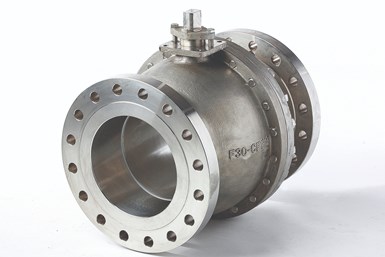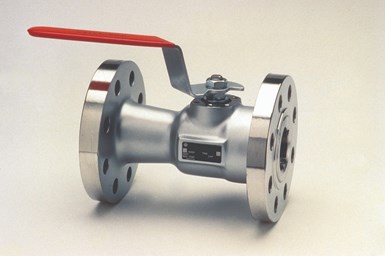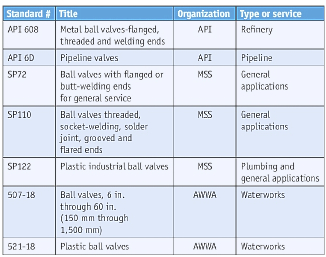API6D Ball Valve Types and Features
API 6D is a standard set by the American Petroleum Institute (API) for valves used in pipelines transporting oil, natural gas, and other liquids. API 6D defines the design, manufacturing, testing, and quality assurance requirements for various types of valves, including ball valves, used in these critical applications.
Types of API 6D Ball Valves
API 6D Ball Valves are designed to ensure reliability, performance, and safety in pipeline systems. There are several types of ball valves that conform to the API 6D standard:
- Floating Ball Valve
- Design: In a floating ball valve, the ball is not fixed to the stem but is allowed to “float” within the valve body. It is pressed against the valve seat by the fluid pressure, ensuring a tight seal when the valve is closed.
- Application: Suitable for low-pressure and medium-pressure systems, as the ball relies on the pressure of the fluid to create a seal.

- Trunnion Mounted Ball Valve
- Design: A trunnion-mounted ball valve has a ball that is fixed at two points (top and bottom) by trunnions (supporting shafts), allowing the ball to remain stationary and only rotate. This type of valve typically requires less actuator torque than a floating ball valve.
- Application: Suitable for higher pressure applications and large-diameter pipeline systems. Trunnion valves are generally preferred in applications where sealing performance and low torque are crucial.

- Top Entry Ball Valve
- Design: The valve body allows for maintenance or servicing of the valve components (such as the ball and seats) through the top without removing the valve from the pipeline.
- Application: Used in systems where easy maintenance is essential without system shutdown or disassembly.
- Side Entry Ball Valve
- Design: In a side-entry ball valve, the valve body is designed such that the ball and stem assembly is inserted from the side.
- Application: Typically used in smaller sizes and more accessible locations for easier maintenance and installation.

- Full Port (or Full Bore) Ball Valve
- Design: A full port ball valve has a bore (internal diameter) that matches the pipe’s internal diameter, offering minimal flow resistance and full flow capacity.
- Application: Ideal for applications requiring unrestricted flow, like pipelines carrying sensitive materials or substances that need to maintain flow integrity.
- Reduced Port (or Reduced Bore) Ball Valve
- Design: In a reduced port ball valve, the bore is smaller than the pipe diameter. This results in some flow restriction compared to a full port ball valve.
- Application: Typically used where space is constrained, or flow capacity is less critical.
Key Features of API 6D Ball Valves
- Design Pressure and Temperature Range:
- API 6D ball valves are designed to withstand a wide range of pressures and temperatures based on the valve class. The design ratings ensure that they perform safely and effectively in both standard and extreme conditions.
- Material Selection:
- The materials used in API 6D ball valves are chosen for their resistance to corrosion, erosion, and wear, as well as their ability to handle high pressures and temperatures. Common materials include stainless steel, carbon steel, and various alloys like Inconel and Hastelloy.
- Fire-Safe Design:
- Fire-safe ball valves are designed to continue to operate in the event of a fire. These valves are typically equipped with secondary sealing mechanisms (e.g., graphite or metal seals) that provide sealing integrity even under high heat conditions.
- Blowout-Proof Stem:
- A blowout-proof stem is a critical feature for safety. It ensures that the valve stem cannot be dislodged, even under extreme pressure, preventing accidental release of valve contents.
- Anti-Static Features:
- Some API 6D ball valves are designed with anti-static features that prevent the accumulation of static electricity, reducing the risk of sparks in volatile environments.
- Seat Materials:
- The valve seats are typically made from soft materials like PTFE, PEEK, or elastomers, but can also be made from metal for higher temperature or more abrasive applications. Seat designs can vary depending on the application, with options for sealing at high pressures, low pressures, or extreme temperatures.
- End Connections:
- API 6D ball valves typically come with various end connections, including flanged, threaded, and welded types. Flanged ends are most common, as they allow easy installation and removal from the pipeline.
- Actuation Options:
- API 6D ball valves can be manually operated (via handwheel or lever) or automatically operated (via electric, pneumatic, or hydraulic actuators). Automated actuation is often used for remote operation or in hazardous environments.
- Double Block and Bleed (DBB) Feature:
- Some API 6D ball valves offer a Double Block and Bleed feature, which ensures a tight seal on both sides of the valve and allows for the safe venting of any trapped fluids between the seats. This is essential for ensuring safe maintenance and operation.
API 6D Ball Valve Applications
- Oil & Gas Pipelines: Used extensively in the transport of crude oil, natural gas, and refined products.
- Chemical Processing: Valves are used for the controlled flow of chemicals and other reactive fluids.
- Water Treatment: Used to control the flow of water in treatment plants.
- Power Generation: In power plants, ball valves regulate steam, water, and fuel in various stages of the generation process.
Summary of API 6D Ball Valve Types and Features
| Type of Valve | Design Features | Application Areas |
|---|---|---|
| Floating Ball Valve | Ball “floats” to create a seal, relies on fluid pressure | Low to medium pressure systems |
| Trunnion Mounted Ball Valve | Ball fixed with trunnions, lower torque required | High pressure and large-diameter pipelines |
| Top Entry Ball Valve | Servicing from the top without removing valve from pipeline | Applications requiring easy maintenance |
| Side Entry Ball Valve | Ball assembly inserted from the side | Smaller systems or accessible locations |
| Full Port Ball Valve | Full bore matching pipe diameter | Unrestricted flow, sensitive materials |
| Reduced Port Ball Valve | Bore smaller than pipe diameter | Space-constrained applications |
Conclusion
API 6D ball valves are designed to provide reliable, durable, and safe service in pipeline systems, especially in the oil and gas, chemical, and power generation industries. The wide variety of designs and features available ensures that these valves can meet specific operational requirements, whether dealing with high pressure, extreme temperatures, or corrosive materials








